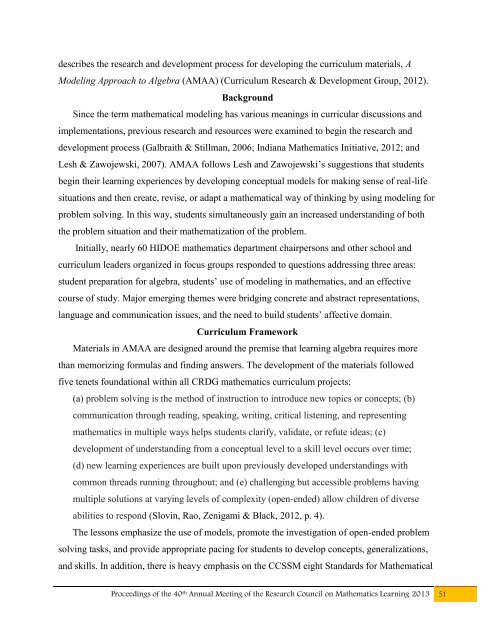2013 Conference Proceedings - University of Nevada, Las Vegas
2013 Conference Proceedings - University of Nevada, Las Vegas
2013 Conference Proceedings - University of Nevada, Las Vegas
- No tags were found...
You also want an ePaper? Increase the reach of your titles
YUMPU automatically turns print PDFs into web optimized ePapers that Google loves.
describes the research and development process for developing the curriculum materials, AModeling Approach to Algebra (AMAA) (Curriculum Research & Development Group, 2012).BackgroundSince the term mathematical modeling has various meanings in curricular discussions andimplementations, previous research and resources were examined to begin the research anddevelopment process (Galbraith & Stillman, 2006; Indiana Mathematics Initiative, 2012; andLesh & Zawojewski, 2007). AMAA follows Lesh and Zawojewski’s suggestions that studentsbegin their learning experiences by developing conceptual models for making sense <strong>of</strong> real-lifesituations and then create, revise, or adapt a mathematical way <strong>of</strong> thinking by using modeling forproblem solving. In this way, students simultaneously gain an increased understanding <strong>of</strong> boththe problem situation and their mathematization <strong>of</strong> the problem.Initially, nearly 60 HIDOE mathematics department chairpersons and other school andcurriculum leaders organized in focus groups responded to questions addressing three areas:student preparation for algebra, students’ use <strong>of</strong> modeling in mathematics, and an effectivecourse <strong>of</strong> study. Major emerging themes were bridging concrete and abstract representations,language and communication issues, and the need to build students’ affective domain.Curriculum FrameworkMaterials in AMAA are designed around the premise that learning algebra requires morethan memorizing formulas and finding answers. The development <strong>of</strong> the materials followedfive tenets foundational within all CRDG mathematics curriculum projects:(a) problem solving is the method <strong>of</strong> instruction to introduce new topics or concepts; (b)communication through reading, speaking, writing, critical listening, and representingmathematics in multiple ways helps students clarify, validate, or refute ideas; (c)development <strong>of</strong> understanding from a conceptual level to a skill level occurs over time;(d) new learning experiences are built upon previously developed understandings withcommon threads running throughout; and (e) challenging but accessible problems havingmultiple solutions at varying levels <strong>of</strong> complexity (open-ended) allow children <strong>of</strong> diverseabilities to respond (Slovin, Rao, Zenigami & Black, 2012, p. 4).The lessons emphasize the use <strong>of</strong> models, promote the investigation <strong>of</strong> open-ended problemsolving tasks, and provide appropriate pacing for students to develop concepts, generalizations,and skills. In addition, there is heavy emphasis on the CCSSM eight Standards for Mathematical<strong>Proceedings</strong> <strong>of</strong> the 40 th Annual Meeting <strong>of</strong> the Research Council on Mathematics Learning <strong>2013</strong> 51




